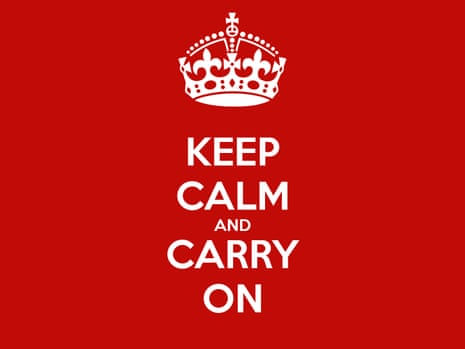The writer and critic Owen Hatherley has become something of a sage of modernism in recent years. Casting his gaze over the built and pop-cultural landscapes, he sorts the echt from the phoney with all the moral certainty of a Ruskin or a Carlyle. His latest book – his sixth – is a short, stimulating polemic against a suite of aesthetic and political motifs united under the promising term, “austerity nostalgia”.
For Hatherley, austerity nostalgia is exemplified by the fetishisation of mid-century Danish furniture; by the coveting of the ex-council flat over the suburban maisonette; by the design aesthetic of the home goods shop Labour and Wait. Austerity nostalgia announces itself in san serif fonts. It glories in the stripped-down design of the underground network and the homely experimentalism of the GPO film unit.
Its influence is observable in fashion (“for men, moustaches and beards, sensible utility wear; for women, the semi-ironic sexualised style usually called ‘burlesque’”) and in music (the folksy, whimsical jangling of Mumford & Sons). In cuisine, its spirit is embodied by Jamie Oliver, with his commitment to a cockney-Orwellian interpretation of hearty English grub, and his deliberate appropriation of the institutional trappings of postwar bureaucracy – both paternalistic and nurturing – in the Ministry of Food TV series and chain of shops. “One could argue”, and Hatherley does, “that he was the latest in a long line of middle-class people lecturing the lower orders on their choice of nutrition, part of an immense construction of grotesque neo-Victorian snobbery.”
The central image of austerity nostalgia is the “Keep Calm and Carry On” poster, the ubiquity of which over the past few years gives Hatherley the “horror-film-like feeling that I was being chased wherever I went by an implacable enemy”. It feels like an irreconcilably mixed bag of cultural artefacts, but Hatherley does a good job of arguing for the essential similarity of their origins. Born of an anxiety over where we are now, such objects betray a misplaced nostalgia for the aesthetics – but not the politics – of the recent past.
According to Hatherley, austerity nostalgia informs political narrative. Both “Red Tories” and “Blue Labour” activists, the latter led by Jon Cruddas and Maurice Glasman, have woven these symbols of nostalgia into a retrospective vision of English radicalism in an attempt to appeal to that chimerical entity, the English “white working class”. Cruddas’s proposal for the establishment of an English parliament to be based in York, the anthem of which would be “Jerusalem”, was, according to Hatherley, simply one of many attempts to rejuvenate the left by constructing an image of historical common-sense solidarity that never truly existed. “The wager is that we can,” he writes, “just by tapping into our own history, find a real popular radicalism that resonates with ordinary people, rather than with small groups of intellectuals discussing Fully Automated Luxury Communism.”
The book ends with the chapter, “Building the Austerity City”, in which Hatherley interprets recent developments in London architecture through the lens of austerity nostalgia. In doing so he identifies a “new typology” of building: the “austere luxury flat, the tasteful 50s-style modernist non-dom investment”. Gone are the gaudy, festooned developments of early noughties regeneration schemes. Instead, London is peppered with sober, well-made, monumental developments (the vast buildings going up around King’s Cross are primary exhibits) that echo the vernacular of mid-century modernism while – with their poor doors and astronomical “affordable” prices – retaining none of its utopian potential. “Whereas in very recent memory,” Hatherley writes, “London seemed to want to look like Dubai-on‑Thames, it now increasingly resembles a cross between Islington in the 1820s and Poplar in the 1950s.”
In tracing these cultural and political artefacts, and the built landscape in which they exist, Hatherley is seeking to describe what the cultural critic Raymond Williams called a “structure of feeling”: “where austerity’s look, its historical syncretism, its rejection of the real human advances of the postwar era had seeped into the consciousness of people who would, when pressed, probably be in opposition to it, even as they performed its aesthetics.” Once we romanticised our lost industrial past, and the loft warehouse flat was the aspirational pad du jour; now we romanticise a lost ideological past, all the while ignoring ongoing attacks on its real institutional legacies. We neglect the NHS because we cannot buy its products. “In Britain today,” Hatherley writes, “we are living through exactly the kind of housing crisis for which council housing was invented in the first place, at exactly the same time as we’re alternately fetishising and privatising its remnants.” As Hatherley is the first to acknowledge, he has done a lot to contribute to this state of affairs: as a vocal and convincing champion of a certain kind of postwar utopian architecture, he has helped to make the council estates of east London look inviting to a generation of young hipsters.
Hatherley is one of the finest – and surely the most provocative – architectural writer we have, and he is at his best here when he focuses on the built environment. Less convincing, because too homogenising, are his readings of the other arts. He offers hardly any literary examples of austerity nostalgia, and there is a curious belatedness to those he does include. He spends a great deal of energy close-reading Alexandra Harris’s 2010 book Romantic Moderns, which argued for a revisioning of English modern – if not modernist – aesthetics as a form of spilt romanticism, dedicating the bulk of a chapter to debunking what he calls Harris’s “art-historical adjunct to the Ravilious print, the Mumford & Sons record and the Keep Calm and Carry On tea towel”, which is, he says, “in many ways more dangerous” than any of these.

Indeed, The Ministry of Nostalgia’s great strength – its clear-eyed, self-confident certainty – is also its most frustrating quality. Hatherley is committed to a fairly monolithic notion of what modernism was, and what it represented. “What, Alexandra Harris asks, if modernism wasn’t really about the transformation of space, the destruction of slums and their replacement with something better for the working class, the overcoming of the 19th century and its physical legacy – but instead an upper-class movement about the rediscovery of roots?” But what if it was neither? Or both? Hatherley ignores the fact that some flavours of modernism, particularly those associated with literature and the visual arts, were backward-looking and politically conservative. Take TS Eliot’s description of James Joyce’s “mythic method”, which, Eliot said, used the classical past to give “a shape and a significance to the immense panorama of futility that is contemporary history”. For many writers and artists, nostalgia was modernism.
Nevertheless, the big question asked by Hatherley here is an important one – and overall he asks it well – does the left now have something to conserve? Should radical socialism renege on its commitment to progressiveness and attempt merely to keep alive those small scraps of the postwar consensus – the NHS, comprehensive education – that do still survive? “If a social and democratic city is going to be built again, it will most probably be built by those who have no investment in the past, no fond memory of it,” Hatherley concludes. But the sad fact is that the green shoots of dissent he does identify as possible solutions to the impasse of austerity nostalgia – the people of Derby Road in Southampton refusing to take part in the television programme Immigration Street; the student protests of 2011; the “Focus E15 Mums” who occupied disused council flats, supported by Russell Brand (the prancing prince of austerity nostalgia who, curiously, goes unmentioned by Hatherley) – hardly add up to much of a countermovement. One wonders what he made of Assemble winning the Turner prize.
This is, nevertheless, a lively and gleefully argumentative book. Even when you disagree with Hatherley, he remains interesting. And there is a good chance, depressingly, that he is right about everything.

Comments (…)
Sign in or create your Guardian account to join the discussion